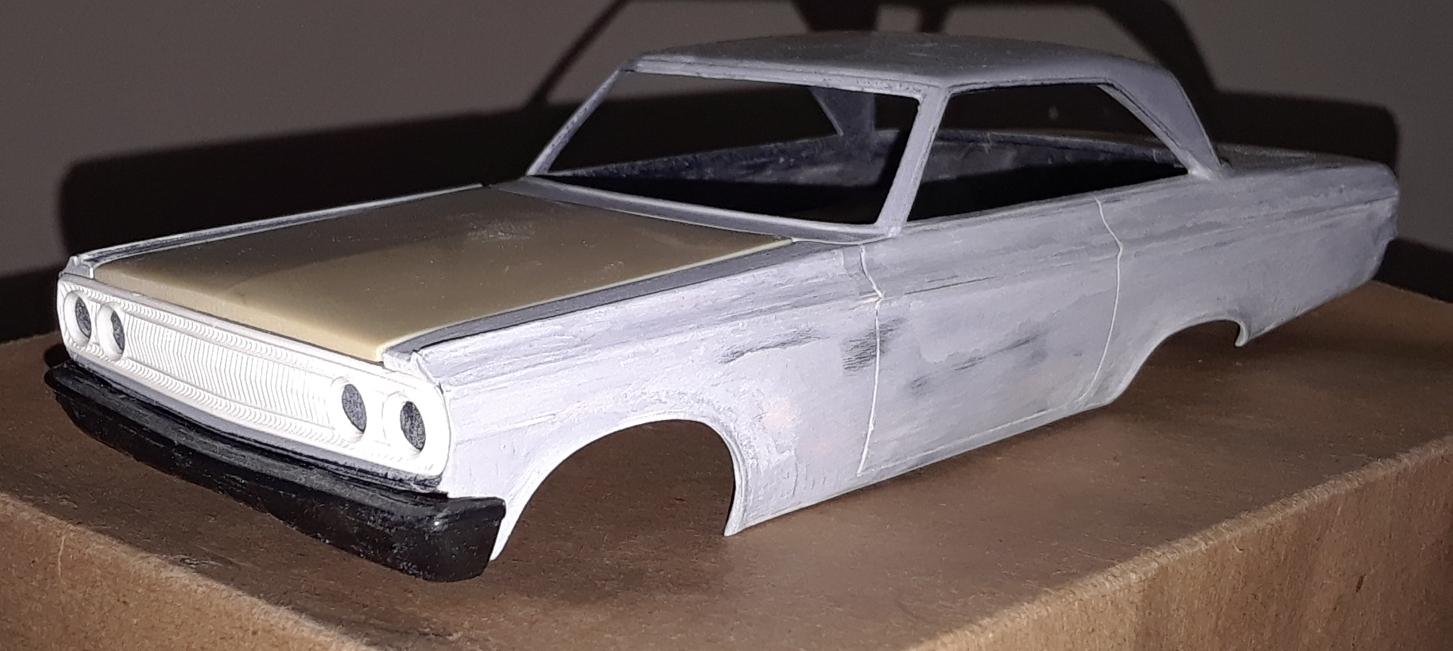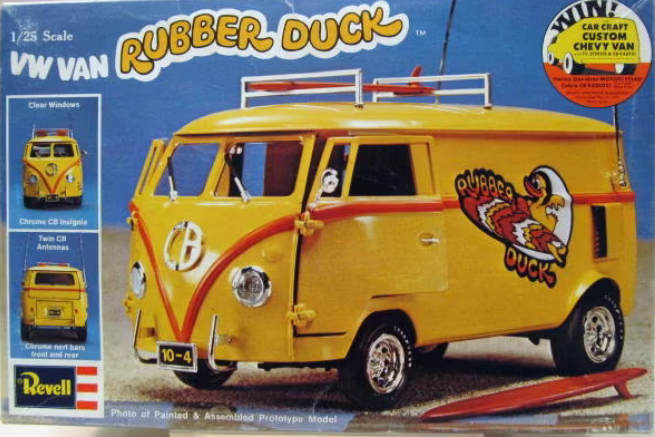
Mark
Members-
Posts
7,360 -
Joined
-
Last visited
Content Type
Profiles
Forums
Events
Gallery
Everything posted by Mark
-
I'd better get mine further along by the time this one comes out. All of the parts are already acquired/paid for, so I may as well finish it. Polar Lights body (modified a lot), MPC grille...
-
Maybe Daimler-Benz needs the money...they've probably burned through the funds they got by looting Chrysler...
- 40 replies
-
- 2
-

-
- mercedes benz
- w196s
-
(and 2 more)
Tagged with:
-
The Cad engine is a good one, but using it backdates the car a bit compared to the Hemi. No big deal, the AMT Fiat includes a 392, and I've got a couple of the Revell parts pack Hemis anyway. If anything, I was hoping Atlantis would dust off the parts pack Buick mill and include it. I figured the 392 wasn't going to make it into this kit.
-
It's the ex-Revell kit with hinged hood, doors, and trunk. I built one a few years ago from a Nineties issue (the Roth issue came out after I had started it). It doesn't just fall together out of the box, but the pieces do actually fit for the most part. Just resist the temptation to redesign or re-engineer it other than to fix the hinges which are on the sloppy side. Window fit on mine was tough, but I'd bet Atlantis is taking a bit more care in molding the kit than Revell did so that might not be as much of a factor. Bottom line...not the best nor the easiest to assemble '57 Chevy kit out there. But if you like Tri-Five Chevies, you should take a swing at sticking one of these together. I used to be bothered by the scale and accuracy differences between different companies' kits of the same car. Now that stuff gets me interested in seeing the differences.
-
mpc minute man.. mustang or camaro
Mark replied to Scott8950's topic in General Automotive Talk (Trucks and Cars)
General Mills owned MPC, and also Lionel, back then. They also owned other companies that made wooden kits and paint-by-number sets. -
The Revell Hemi engine never came with a carburetor setup of any kind. You sure that's not the Cadillac engine?
-
mpc minute man.. mustang or camaro
Mark replied to Scott8950's topic in General Automotive Talk (Trucks and Cars)
MPC often used photographs on the boxes of its drag car kits. When they used artwork, it was either because there was no 1:1 car, or the kit was so far off from the 1:1 that they couldn't retouch the photo to match the kit. Windshield wipers added to Pro Stock cars, moving hood scoops forward on the hood, changing wheels, adding shaker hoods to funny car bodies, things like that. -
Mr. Gasser.
-
Tools using heat, probably modified soldering irons or something similar, were used to assemble promo models. If you have ever taken an old promo apart, you'd see the interior bucket attached by heating the end of the mounting posts and mushrooming them over. The kits instead had plastic rings that slipped over the posts. Often the small parts like taillight lenses would have super long pins on the back side. Those would go through a hole in the chrome bezel, then through a hole in the body, and likewise get heated and folded over on the inside of the body.
-
Atlantis Models has bought another lot of tooling/molds.....
Mark replied to Dave Van's topic in Car Kit News & Reviews
The bus was actually first issued around 1958, as a 23 window. The '67 update changed the back end to the wider rear hatch (eliminating the corner windows) and added vinyl tires. -
Pontiac Sprint OHC 6: what kits, where parts?
Mark replied to W Humble's topic in Model Building Questions and Answers
MPC '67-'68 Firebird annuals, '69 mid-year Trans-Am, and reissue Firebirds including the one-shot convertible. '67 engine was all plated, or very nearly so. The '69 annual may not have it as that one includes the turbine engine, but it's not likely you will trip over one of those. The black MPC '69 Camaro has it too, as it uses the Firebird chassis and interior just like the MPC annual Camaro did. (The annual had a Chevy engine though, also the turbine that was in the Firebird also.) One more: MPC Daytona transporter. No transmission (that kit uses a Toronado FWD unit), and that one might not have stock accessories (air filter, exhaust manifold). -
Atlantis Models has bought another lot of tooling/molds.....
Mark replied to Dave Van's topic in Car Kit News & Reviews
You'd have to check the most recent issue of each kit and see where it was made. If it was made in USA, there's a chance Atlantis got it. I did pick up the last issue of the Beetle...man, is that thing rough. -
I bought one recently, didn't have one back in the day. It looks like it will go together easily enough. Styling is subjective...I'm looking at it as a canvas for restyling, the front end in particular.
-
Packard coach/tour bus
Mark replied to Earl Marischal's topic in General Automotive Talk (Trucks and Cars)
World's longest rat rod...Tractor Supply flat black, red rims, whitewalls painted on with roof paint, and more saw blades and rebar than you've ever seen on one vehicle before... -
I'd bet Satco's issue was licensing.
-
The idiots toss empty water bottles wherever they happen to be when the bottle is empty. Too much work to carry it to wherever the next trash can is, or stick it back into the bottle holder on their bike.
-
I thought the Nomad's drag version looked a lot like the blue '55 sedan, but never actually compared the two. The blue 1:1 '55 sedan was a local car. My older brother told me that, when he bought another car ('52 Mercury convertible) in 1972, that '55 was in the garage next to it. It was also for sale, but in 1972 it was just an old drag car, minus engine, that was never really competitive to begin with. Few people would have bothered to try to put it back on the street back then. His guess was that it probably ended its days on a dirt track, or got parted out. It had the NHRA legal 10% engine setback (furthest forward spark plug behind the front axle center line by 10% of the stock wheelbase). But the drivers' seat could not be moved further back than the B-pillar, leaving a cramped drivers' compartment. The gas pedal was nearly vertical. The car was nicely finished, as I remember it had a custom interior with chromed garnish moldings around the windows. Body/paint and possibly the front axle installation were by Ron Gerstner, who built a few well-known custom cars. Monogram copied his '34 Ford coupe altered for one of their 1/32 scale drag car kits.
-
Packard coach/tour bus
Mark replied to Earl Marischal's topic in General Automotive Talk (Trucks and Cars)
Anyone for a top chop? -
Shake the old stuff up really well a couple of days before you intend to start using it. You should be able to "roll" or "slide" the agitator around the bottom of the can. If you can't do that, you've still got solids settled down there and you'll be spraying watery primer.
-
Satco announced an issue of this pickup in unassembled form, (I believe) with a 4 x 4 version added. It never appeared, nor did their announced '66 Impala or belly tanker kits. The only issue I'm aware of is the assembled Wheat version, in turquiose. Those have vacuform glass, as the clear parts are always a separate tool which is easily separated from the main tool.
-
Slim Jim = cardboard soaked in A1 steak sauce! And, don't spare the salt. One of my brothers spotted me eating one, once...for several years, I'd get a gift package of Slim Jims for Christmas.
-
Are these Pickup beds interchangeable?
Mark replied to vintagerpm's topic in Model Building Questions and Answers
The AMT '53 pickup has a similar tailgate which is a separate part. That kit includes two tailgates, you might be able to get a stock one from someone who used the optional one. -
Someone brought an in-progress '63 to a local swap meet this past weekend. It was a running/driving car with a Chevy 292 six cylinder engine (and yes, it was a 292). It was a two-door sedan, body looked pretty good but I didn't look underneath. The interior was gutted with seats stuck in from something newer. The seller was asking $3,000...probably wave a bit less under his nose and get it. A lot of people were looking, I left early and didn't see anyone getting serious though. Some front suspension parts are supposedly hard to find, but this was claimed to be a low mileage car. The AMC two piece front spindles would make a disc brake swap pretty easy, so I'm told. Probably a good project for someone, though I'd want a later AMC six myself.
-
Are these Pickup beds interchangeable?
Mark replied to vintagerpm's topic in Model Building Questions and Answers
I wouldn't bother swapping beds, I'd just change tailgates instead. I de-Foosed one of those pickups when it first came out, knocked the lettering off of the tailgate and scratched a set of tall FORD letters using a '63 tailgate as an example.






